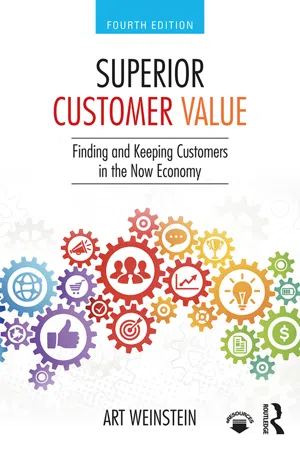
- 206 pages
- English
- ePUB (mobile friendly)
- Available on iOS & Android
About this book
Superior Customer Value is a state-of-the-art guide to designing, implementing and evaluating a customer value strategy in service, technology and information-based organizations. A customer-centric culture provides focus and direction for an organization, driving and enhancing market performance.
By benchmarking the best companies in the world, Weinstein shows students and marketers what it really means to create exceptional value for customers in the Now Economy. Learn how to transform companies by competing via the 5-S framework – speed, service, selection, solutions and sociability. Other valuable tools such as the Customer Value Funnel, Service-Quality-Image-Price (SQIP) framework, SERVQUAL, and the Customer Value/Retention Model frame the reader's thinking on how to improve marketing operations to create customer-centered organizations.
This edition features a stronger emphasis on marketing thinking, planning and strategy, as well as new material on the Now Economy, millennials, customer obsession, business models, segmentation and personalized marketing, customer experience management and customer journey mapping, value pricing, customer engagement, relationship marketing and technology, marketing metrics and customer loyalty and retention. Built on a solid research basis, this practical and action-oriented book will give students and managers an edge in improving their marketing operations to create superior customer experiences.
Frequently asked questions
- Essential is ideal for learners and professionals who enjoy exploring a wide range of subjects. Access the Essential Library with 800,000+ trusted titles and best-sellers across business, personal growth, and the humanities. Includes unlimited reading time and Standard Read Aloud voice.
- Complete: Perfect for advanced learners and researchers needing full, unrestricted access. Unlock 1.4M+ books across hundreds of subjects, including academic and specialized titles. The Complete Plan also includes advanced features like Premium Read Aloud and Research Assistant.
Please note we cannot support devices running on iOS 13 and Android 7 or earlier. Learn more about using the app.
Information
Part I
Customer Value Mindset
1
Customers Want Exceptional Value Now!
Key Takeaways
- Why customer value must be the basis for global marketing strategy.
- Become familiar with the S-Q-I-P (Service-Quality-Image-Price) framework for creating customer value.
- Know what is means to be a value-creating organization.
- Understand the evolution from the new economy to the Now Economy.
- Recognize how to create value for the new generation of customers.
The Strategic Importance of Customer Value
So, What Does Value Really Mean?
- Understanding customer choices
- Identifying customer segments
- Increasing their competitive options (for example, offering more products)
- Avoiding price wars
- Improving service quality
- Strengthening communications
- Focusing on what is meaningful to customers
- Building customer loyalty
- Improving brand success
- Developing strong customer relationships
Table of contents
- Cover
- Half Title
- Title Page
- Copyright Page
- Dedication Page
- Table of Contents
- List of Figures
- List of Tables
- List of Customer Value Checklists (CVC)
- List of Customer Value Insights (CVI)
- Preface
- Acknowledgments
- Part I Customer Value Mindset
- Part II Customer Value Strategies
- Part III Customer Value Measurement
- Appendix: Customer Value Funnel Questions
- Index